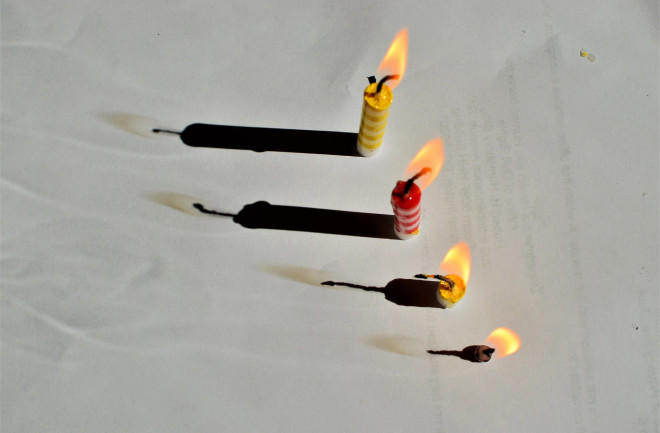Unless you’re Peter Pan, you can’t lose your shadow. At least, not permanently.
Shadows crop up wherever light is obstructed by an object, and they come in a range of shapes and sizes. In 2012, for example, physicists captured the first-ever view of an atomic shadow by shining a laser at a single ytterbium atom in a vacuum chamber.
And on a much larger scale, our moon blocks the light of the Sun from reaching Earth during solar eclipses. Millions of people will witness this firsthand in 2024, when a much-anticipated totality is projected to sweep across North America.
But what happens if the obstruction itself is a light source, too — like a candle’s flame or a roaring campfire?
What Is Fire Made Of?
First of all, most fires are more than just a light source. A typical flame contains multitudes: hydrocarbon and oxygen molecules actively being burned, the carbon dioxide and water vapor produced as a result, and impurities like soot, smoke and half-burnt fuel.
The yellow light that we typically associate with fire, in fact, is created when little bits of soot are heated up so much that they glow. These yellow flames are called luminous ones, and all that extra soot ultimately means they aren’t being fed enough oxygen to turn fuel into carbon dioxide.
Non-luminous flames, however, are a different story. Because these have access to plenty of oxygen, they burn cleaner (read: no soot) and hotter. They also tend to burn blue, rather than the traditional yellow.
Does Fire Have a Shadow?
What does all this have to do with shadows? Well, the more visible impurities that a fire contains — soot, but also perhaps aerosolized candle wax — the greater the chance that you’ll be able to see its shadow.
Of course, even a fire that is burning cleanly has a shadow of sorts. This typically looks like faint, dancing ripples, and it’s a visual representation of the super-hot gas molecules dancing around inside the flame; because the molecules are much hotter than the surrounding air, they bend or diffract light.
Photographers may recognize it as the same science that allows a camera lens to focus light.
Read More: Do Atoms Ever Touch?
What Is Light, Anyway?
Try pointing a weak flashlight at a blazing campfire, however, and you’re unlikely to see much of a silhouette. For a flame (or any light source) to generate a shadow visible to the human eye, it must be obstructing an even brighter lighter source — like sunlight.
Take note that any shadow is not the result of incoming light being scattered by the light produced by the fire. Physics tells us that light beams never directly interact with each other, whether that means bouncing off or absorbing each other.
Why? Photons, the tiny particles that comprise light waves, by nature can overlap, pass through one another and even inhabit the exact same positions. They’re the very definition of “mind your own business.”
Photons also lack electric charge and a magnetic moment, things that electromagnetic fields take advantage of to interact with objects. But without these, one light beam can never interact with any other light beam.
In short, fire doesn’t produce a shadow like you or I might, by blocking all light from passing through it. But it does partially block light — and thanks to a bunch of ultra-hot gas molecules, a fraction of the light will likely be deflected back or diffracted.
To avoid the Peter Pan effect at home, make sure you’re pointing a bright light beam or direct sunlight at a luminous flame that has lots of soot or smoke.
Read More: How Flames Behave in Space

